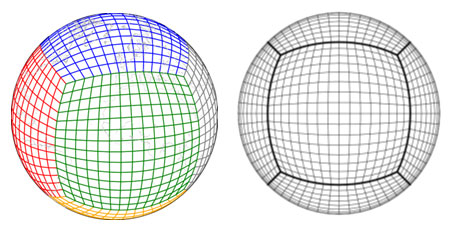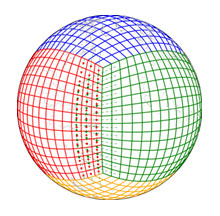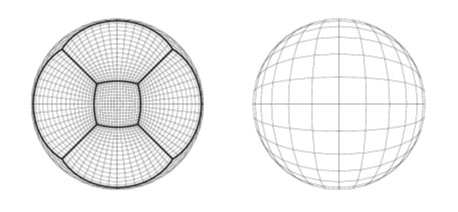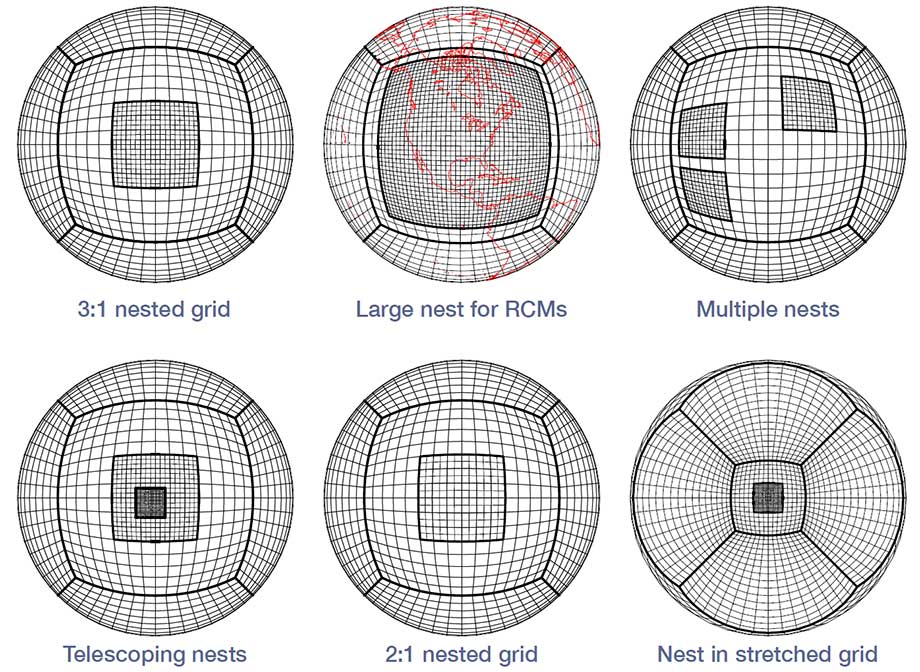FV3: Finite-Volume Cubed-Sphere Dynamical Core
Grids
FV3 on Cubed-Sphere Grid
The transport scheme used by FV3 is documented in three main publications (Lin et al. 1994, Lin and Rood 1996, and Putman and Lin 2007). The Putman-Lin scheme is a refinement of the Lin and Rood (1996) scheme for the various Cubed-Sphere grids. Currently, the Gnomonic grid is the grid of our choice, due to its best grid uniformity.

Cubed-Sphere Edge Handling
At the edges of the cubed-sphere tiles, two one-sided 3rd order extrapolations were averaged to form a directionally symmetric scheme across the edges (see Putman and Lin 2007). This averaging, however, locally reduces the formal accuracy from 4th order in the interior to only 2nd order at the edges of the cubed-sphere, and it creates some grid imprinting due to the mild discontinuity of the great-circle grid lines and some reduction in accuracy. Fortunately, the grid imprinting is greatly reduced at increasing resolutions, since the two-sided extrapolation algorithm converges although more slowly than in the interior. At NOAA’s Global Forecast System’s current resolution of 13km the grid imprinting is practically nonexistent for weather predictions. Nonetheless, to improve lower resolution climate applications, we are still working on a revised edge handling algorithm, by using an extended-grid approach, so the algorithm remains 4 th order accurate at the edges. We believe improved edge handling will further reduce the already-small grid imprinting.

Grid Stretching and Two-way Nested Grid
FV3 supports two means of grid refinement: a continuous grid stretching and two-way grid nesting. Grid stretching is described in Harris et al. (2016 CJLI, accepted). Stretching is achieved by applying an analytic Schmidt (1977) transformation to the cubed sphere grid to smoothly reduce the size of one cube face, and to center that enhanced-resolution cube face over the targeted region of interest. The resulting grid has a smoothly-varying resolution between the enhanced- and degraded-resolution regions (antipodal point of the target). The solver can be used un-modified on this stretched grid, although the time step is restricted by the smallest grid cell. The refinement ratio can be any floating point value; short-term storm-scale simulations have been performed using ratios as high as 80, so that it is operationally feasible within a GFS-like global model to have local grid-cell widths as high as 500 meters. This configuration has been used to explore tornado-producing supercell predictions.

The two-way nested algorithm is fully described by Harris and Lin (2013). The nested and coarse grids are run concurrently on separate sets of processors, to aid load balancing between the processors dedicated to the coarse grid and those dedicated to the nested grid, and to allow simultaneous, coupled regional and global solutions. Each grid may use different settings appropriate for its own resolution, including different time steps and different physics parameterizations. Only the winds and temperature are updated to the coarse grid in the two-way interaction; the coarse-grid air mass field is undisturbed, trivially conserving mass. The two-way nested algorithm may be extended to multiple telescoping nests, and supports any integer refinement ratio. Further resolution enhancement can be found by combining the stretched and nested grids.

Both the nested and stretched grids have been used for multi-decadal regional climate simulations, in which the resolved regional scales are able to directly interact with the global-scale circulation. Efficient climate simulations with 25-km grid-cell widths over North America and the Western Pacific were performed by Harris and Lin (2014); economical high-resolution climate simulations with 10-km grid-cell widths over the same regions were performed by Harris et al. (2016 CJLI, accepted). Robust improvements to orographic precipitation, the diurnal cycle of continental precipitation, and tropical cyclone intensity were found in the refined regions compared to the uniform-resolution base global grids, with little evidence of grid artifacts. In particular, any grid artifacts are much less severe than those found from one-way nesting (Harris and Lin 2014). The large-scale climate was not appreciably degraded by the use of either grid stretching or nesting; in some cases, particularly the 10-km stretched grid, the errors in large-scale climate statistics was found to decrease compared to the uniform-resolution base grid.


